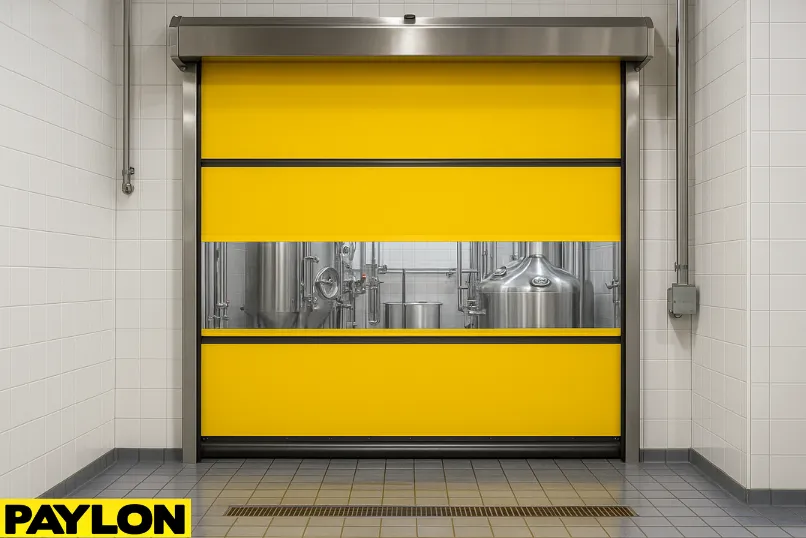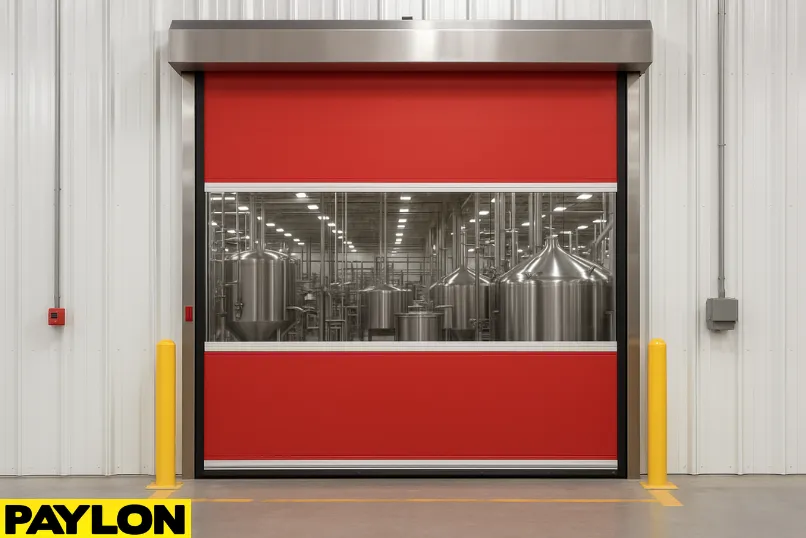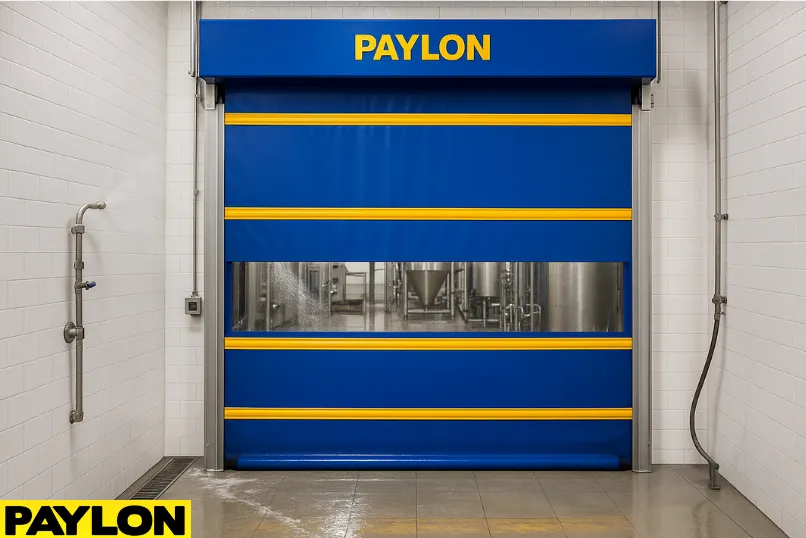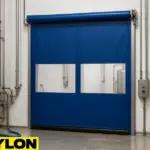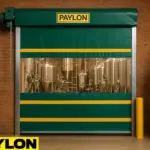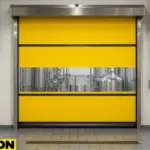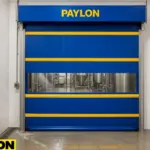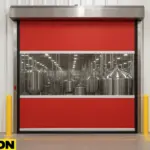Hands-Free, Hassle-Free, Washdown-Ready
See why more breweries and distilleries are switching to motorized vinyl doors, built to handle heavy traffic, strict sanitation, and daily cleaning protocols.
Washdown zones demand doors that withstand moisture, traffic, and daily cleaning. This guide explores how motorized vinyl roll-up doors work, their key benefits, where they’re used, how to compare motor types, answers to common questions, and how to choose the right door for your brewery or distillery.
Which Motor Type Is Best for Your Washdown Facility
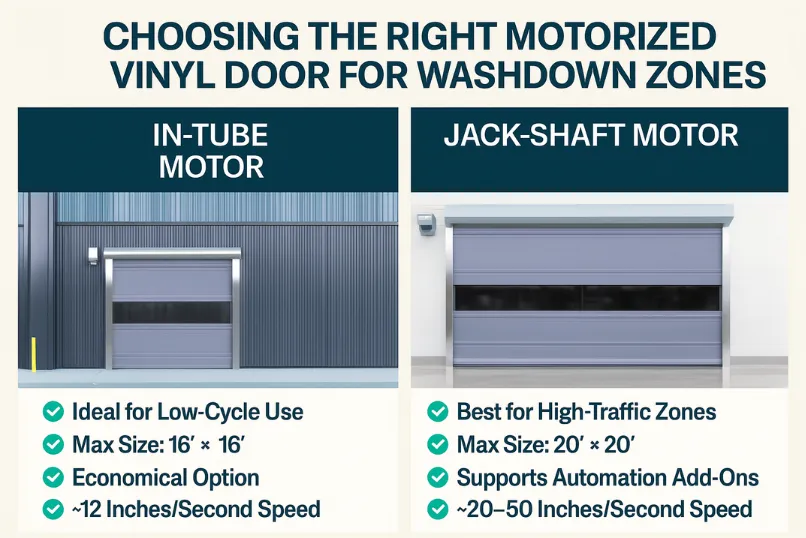
Choosing the right motorized vinyl door for your brewery or distillery washdown zone comes down to usage needs. In-tube motors are perfect for smaller openings and light daily use, while jackshaft motors excel in high-traffic zones that demand speed and automation. This quick guide helps you compare options based on door size, cycle speed, and upgrade potential, so you can invest in a solution that keeps your facility clean, compliant, and running efficiently.
How Motorized Vinyl Doors Work in Washdown Zones
Now that you know why these doors matter, let’s take a closer look at how they work in practice. Built for clean environments, motorized vinyl doors are engineered to handle constant moisture, movement, and sanitation.
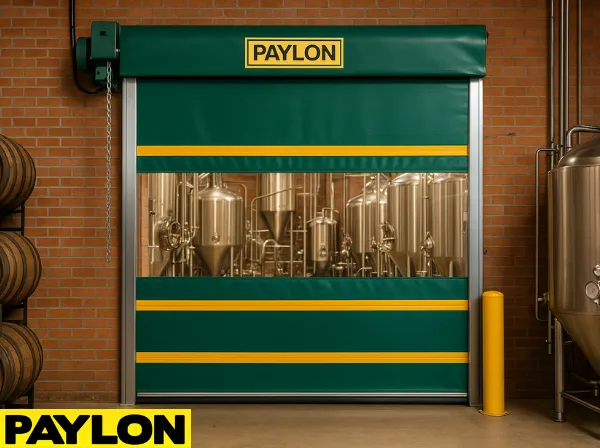
Here’s what makes them effective in washdown zones:
Motor Options for Every Facility:
In-tube motors offer a compact solution for moderate daily use, while jackshaft motors deliver high-speed performance in larger, high-traffic zones.
Tear-Resistant Vinyl Curtain:
The vinyl material resists water, chemicals, and daily cleaning, ideal for maintaining a hygienic barrier.
Soft-Close Bottom Bar:
This cushioned feature minimizes noise and impact while sealing tight to reduce contamination risks.
Optional Viewing Window:
Improves visibility between rooms without compromising sanitation or safety.
Hands-Free Operation:
Motion sensors or remote activation keep workflows smooth and contact to a minimum.
Together, these features create a durable, low-maintenance system that supports both cleanliness and efficiency in brewery and distillery settings.
Benefits That Make a Difference
Knowing how these doors function is helpful, but it’s their real-world benefits that make them a smart investment for breweries and distilleries.
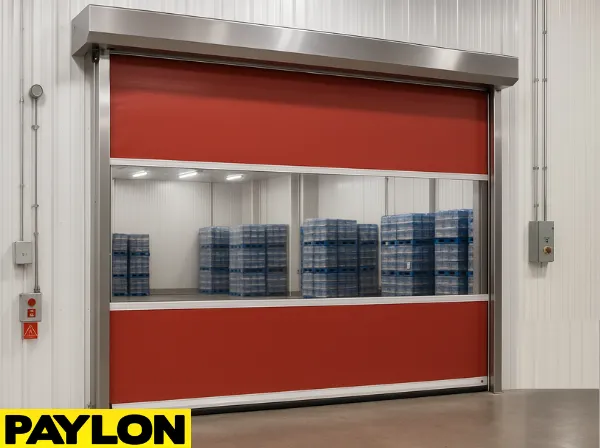
Sanitation You Can Count On:
The non-porous vinyl surface is easy to clean and ideal for areas requiring frequent washdowns, helping reduce contamination risks.
Boosted Efficiency:
Quick open-and-close speeds limit delays, allowing staff and equipment to move through high-traffic zones without slowing down production.
Built-In Safety:
A breakaway bottom bar minimizes damage during collisions and resets automatically, preventing costly downtime.
Cost-Effective Performance:
Compared to steel high-speed doors, these vinyl options offer essential performance at a lower cost, without sacrificing reliability.
These doors deliver where it counts, whether you're focused on cleanliness, productivity, or savings. They're built to support the daily demands of brewery and distillery operations.
Where You’ll Find These Doors in Action
Now that you know how these doors work and why they’re effective, let’s look at where they’re typically installed in brewery and distillery settings. These locations benefit most from their sanitary design and quick, reliable access.
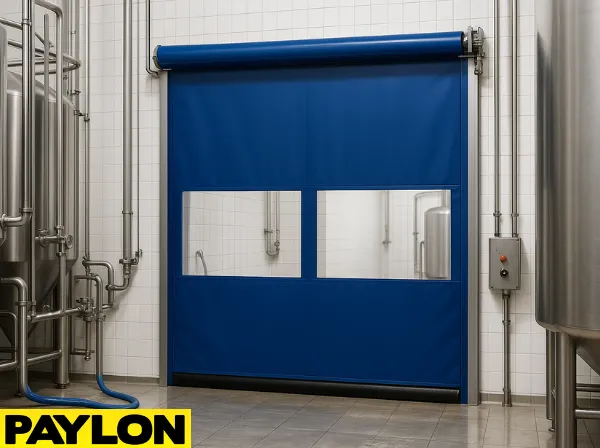
Common installation zones include:
Tank Rooms:
Used to maintain cleanliness and allow fast entry for cleaning or inspection.
Transfer Zones:
Positioned between brewing stages to streamline movement while preserving hygiene.
Kegging and Bottling Lines:
Help protect packaging areas from moisture and airborne contaminants.
Dry vs. Wet Zones
Act as barriers between areas with frequent washdowns and those needing dry conditions.
These strategic placements support smoother operations and cleaner environments, helping facilities stay both productive and compliant.
Feature Comparison: In-Tube vs. Jackshaft Motors
Now that you’ve seen where these doors are commonly used, the next step is understanding which motor type fits your setup best. Whether your space sees light use or high-traffic operations, this quick comparison can help you align your facility’s needs with the right performance level.
| Feature | In-Tube Motor | Jackshaft Motor |
|---|---|---|
| Max Door Size | Up to 16' × 16' | Up to 20' × 20' |
| Best For | Low to moderate traffic | High-traffic environment |
| Mounting Type | In-jamb or face-of-wall | Stand-off or custom mounting |
| Speed & Efficiency | Moderate | Higher with smart controls |
| Washdown Resistance | ✅ | ✅✅ |
This side-by-side view keeps the decision-making process simple. Use it as a reference when reviewing door specs, selecting locations, or working with your installer to get the right fit.
Frequently Asked Questions
Frequently Asked Questions About Motorized Vinyl Doors
Do motorized vinyl doors meet FDA or USDA standards?
Yes. Most models are made with non-porous, smooth vinyl surfaces that meet sanitation standards for food and beverage production. When properly installed, they support FDA and USDA compliance in washdown areas.
What type of motor is best for high-traffic brewery zones?
Jackshaft motors are ideal for high-traffic areas. They offer faster opening speeds, greater durability, and support for automation—perfect for busy transfer points or equipment zones.
Are vinyl roll-up doors safe for food production areas?
Absolutely. Their seamless vinyl curtain is easy to clean, resists moisture, and minimizes manual contact with hands-free operation options.
How long does installation usually take?
Most doors can be installed within one working day, depending on the size of the opening and mounting requirements. Retrofit installs may take slightly longer.
Why are vinyl roll-up doors better than traditional swinging doors?
They open faster, seal tighter, and take up less space. More importantly, they reduce manual handling, which lowers contamination risk in clean zones.
Can these doors be customized for non-standard openings?
Yes. Both door size and mounting style can be tailored to fit your facility’s layout, whether you have low ceilings, wide spans, or uneven surfaces.
Do these doors require frequent maintenance?
No. They are designed for high durability and minimal upkeep. Components like the curtain and bottom bar can be replaced easily if needed.
Can I use motion sensors or remotes with these doors?
Yes. Motorized vinyl doors are compatible with motion sensors, remotes, keypads, and other hands-free access systems.
What vinyl curtain options are available?
Most doors come in 22 oz or 40 oz vinyl. Heavier-duty options are recommended for frequent washdowns or harsher cleaning chemicals.
Do these doors help with temperature or humidity control?
Yes. The tight seal helps separate rooms with different temperature or humidity levels, reducing air exchange and improving energy efficiency.
Are they effective at separating wet and dry zones?
Yes. They serve as a physical barrier between washdown areas and packaging or dry storage zones, helping you stay compliant and efficient.
How often should I expect to replace the bottom bar?
Only when damaged. The bottom bar is designed to absorb impacts and can be quickly swapped out without removing the entire door.
Can these doors be added to existing facilities?
Yes. They're suitable for both new builds and retrofits, and can be installed without major modifications to your walls or framing.
What is the typical lifespan of a motorized vinyl door?
With regular use and proper care, these doors can last anywhere from 7 to 10 years or longer—even in high-use production environments.
Do I need a viewing window in the door?
Not necessarily, but clear panels can help staff see through the door safely without opening it, which improves traffic flow and reduces accidents.
What safety features are available?
Standard options include soft-close bottom bars, automatic reset after impact, photo eyes, and emergency stop controls.
Are they built to handle heavy washdowns?
Yes. The vinyl curtain and hardware are designed for daily exposure to water, detergents, and high-pressure cleaning routines.
How do I choose between in-tube and jackshaft motors?
In-tube motors are best for smaller doors with moderate use. Jackshaft motors are preferred for larger doors, high-frequency access, or when automation is a priority.
Are these doors noisy during operation?
No. They operate quietly, which makes them ideal for indoor production spaces where noise can be a concern.
Can I still operate the door during a power outage?
Yes. Many models include or support a manual override option so you can still access key areas when power is lost.
Conclusion: Upgrade Your Washdown Zone with Confidence
When it comes to brewery and distillery washdowns, the right door isn’t just a nice-to-have, it’s a performance upgrade. Motorized vinyl doors help you keep operations flowing with less mess, fewer delays, and a lot more confidence. From faster access and tighter seals to cleaner zones and easier compliance, these doors are built to support your workflow without compromise.

